
A Fahua Tower, half of the history of Jiading.
At the confluence of Lianqi River and Hengli River in the center of Jiading Ancient City in Shanghai, stands the Fahua Tower, the central landmark of Jiading City. As a cultural relic protection unit in Shanghai, the Fahua Tower started repairs in April this year and was completed at the end of July. On August 28, the unveiling ceremony for the restoration and completion of the "Millennium Fahua Tower" was held in the courtyard in front of the Fahua Tower. Together with Fahua Tower, there is also "Wenfeng Jiamai-The History and Culture Theme Exhibition of Fahua Tower". For the first time, cultural relics unearthed from Huata gathered in Jiading for exhibition.
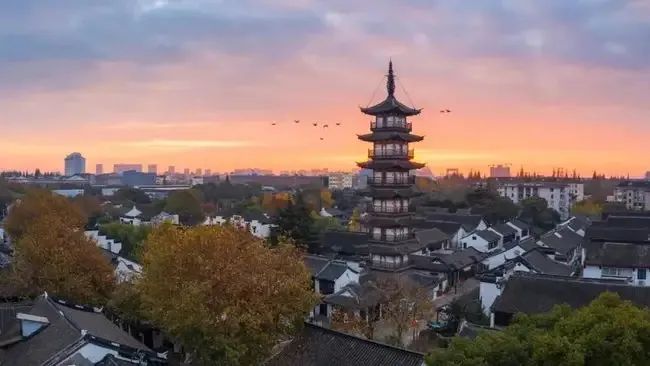
Jiading cultural scene "Jinsha Sunset"
Fahua Tower, also known as Jinsha Tower, is located in the south of Denglong Bridge (Zhouqiao) in the center of Jiading ancient city. It was first built in the Kaixi period of the Southern Song Dynasty (1205-1207), and has been repaired many times in Yuan, Ming, Qing and modern times. It is regarded as "the writing style of the county, the Xuanwu of learning", which has witnessed the prosperity and profoundness of Jiading's culture and education.
Under the tower are ancient bridges and shops, and the river flows through it, forming a beautiful scene of Jiangnan water town integrating one tower, two rivers, three streets and four bridges. Since ancient times, the water, the moon and the sky, and the shadow of the pagoda hanging down to the rainbow have constituted one of Jiading's cultural attractions, the "Golden Sands Sunset". Throughout the ages, many literati have climbed to the top of the tower to overlook the entire ancient city of Jiading, leaving behind many calligraphy and poems.
Fahua Pagoda is a seven-level square pavilion pagoda with wooden ladders inside. After the completion ceremony, The Paper followed the flow of people into the tower, wanting to reflect on the past along the footsteps of literati. I saw that the wooden ladder in the tower was narrow and steep, only wide enough for one person, who climbed to the top of the tower with hands and feet, and had a panoramic view of the whole city. However, for safety reasons, Fahua Tower is not yet open to the public.

Climbing on the tower, you can have a panoramic view of the whole city (Photographed by The Paper)
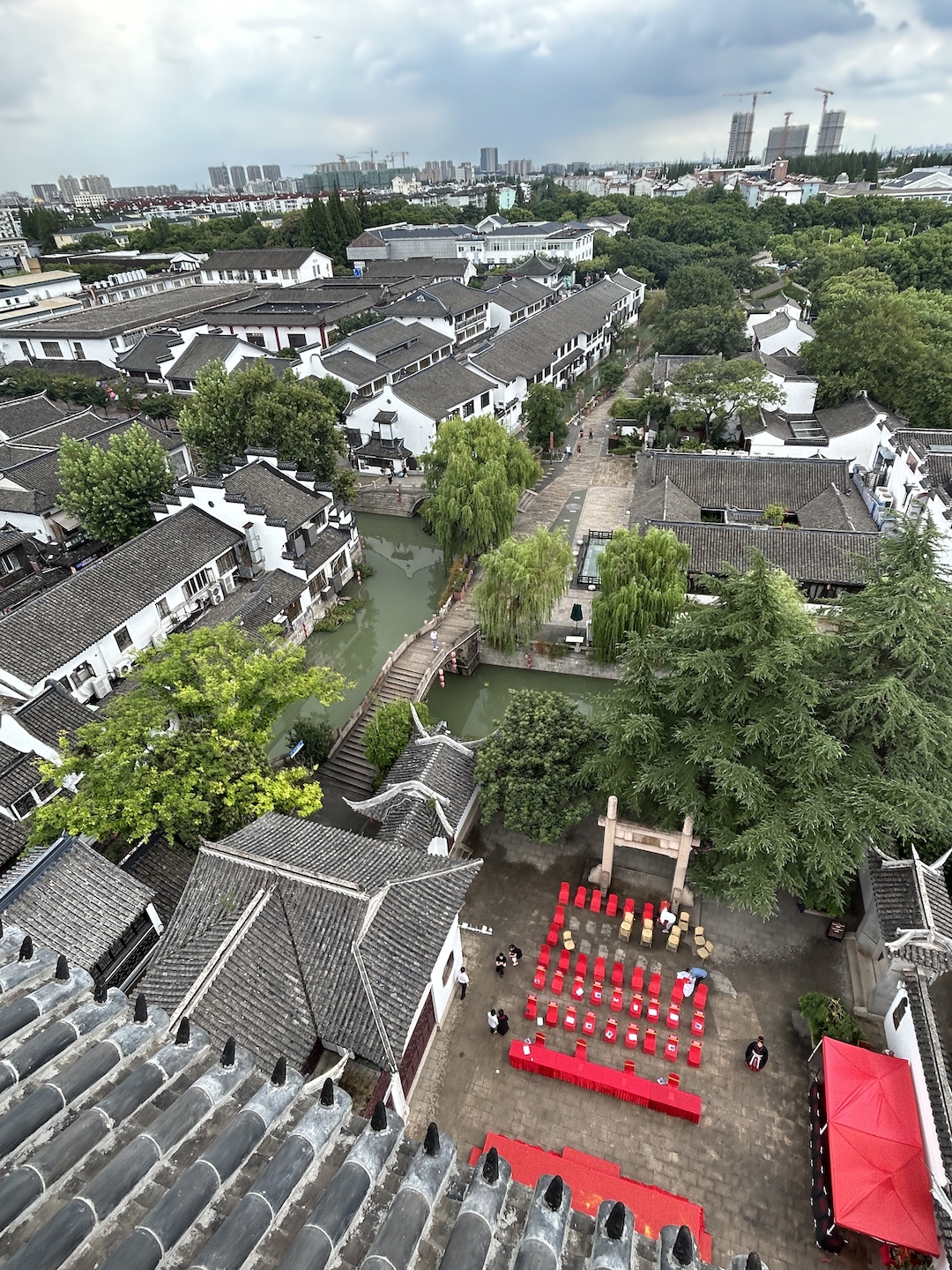
Climbing on the tower, you can have a panoramic view of the whole city (Photographed by The Paper)
After 3 months of repairs, the Fahua Tower regained its splendor
In the long history of more than 800 years, Fahua Tower has been rebuilt and repaired several times. It was rebuilt from Yuan to Dayuan (1308); during the Wanli period of the Ming Dynasty, only one floor of the pagoda remained; in the 36th year of Wanli (1608), Chen Yiyuan, the magistrate of the county, raised funds to rebuild the Fahua Tower and restore the seven-story tower; in the Qing Dynasty, Kangxi, Yongzheng, During the Qianlong, Jiaqing and Republic of China years, it was repaired many times. The last overhaul of Fahua Tower was from 1995 to 1996, more than 20 years ago.

Fahua Tower (Photographed by The Paper reporter)
In recent years, Fahua Tower has suffered from other diseases that obviously affect the safety of the tower, such as tower brake tilt and corrosion, roof settlement and damage, rotten and swaying railings, and cracked and tilted beams and columns. The existence of these diseases not only endangers the safety of cultural relics, but also affects the value of cultural relics and historical features of Fahua Tower.
In April this year, the Fahua Tower renovation project was officially launched. According to the local Bureau of Culture and Tourism, the restoration of Fahua Tower follows the principles of "repairing the old as it is" and "minimum intervention", and adopts traditional craftsmanship to preserve the original appearance of the ancient building to the greatest extent. In this repair, we have completed projects such as shrinking eaves, derusting pagoda brakes, reinforcing and normalizing wooden components, and painting inside and outside, targeting at the cultural relics.

Overall Pagoda Brake Repair (Source: Released by Shanghai)
The "treasure bottle" on the top of Fahua Tower is shaped like a gourd, and there are some iron dew plates, iron rings, etc., collectively referred to as "tasha". There are four iron cables under the tip of the tower brake, which are tied to the four corners of the top roof and play the role of fixing the tower brake. They are called "wave wind cables". Tasha is the most prominent mark on the "watching the whole tower" and the tower. In this repair, the "Aquarius" was re-flying gold. In order to achieve the best repair effect, the gold paint was painted three or four times before and after, repeatedly polished, and finally gold leaf was pasted to restore its original appearance. Because the original brake chain was thin, some areas were prone to breakage. During the repair, it was supplemented according to the existing materials and shapes. The iron rings used in the preparation of the iron chain were manually forged, and treated with aging and rust prevention.
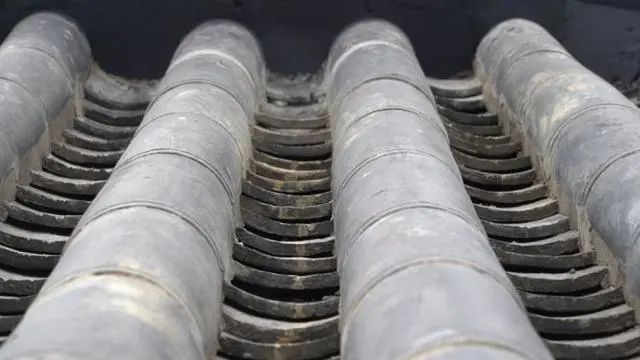
Resurfacing the roof (Source: Released by Shanghai)
During the renovation, the original components were also used as much as possible, and the missing components were supplemented. After the repairs of the bucket gongs, wooden frames, and wooden rafters under the eaves were completed, the roof was resurfaced. The Fahua Pagoda, which has been repaired, is illuminated by the sun, and the "treasure gourd" on the top of the tower regains its golden halo and glows with new brilliance.
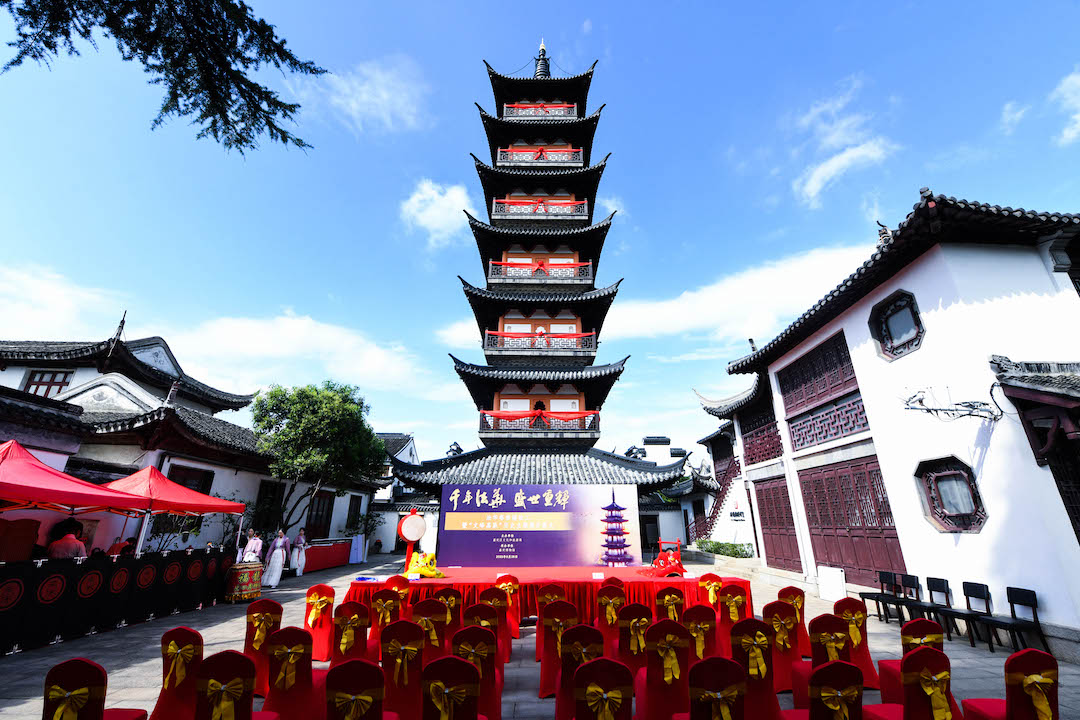
Fahua Pagoda completed
A Fahua Tower, half of the history of Jiading
It is reported that Fahua Pagoda was originally named Jinsha Pagoda. It used to be a navigation mark for rivers and seas. It was later renamed Fahua Pagoda. In the folk, Fahua Pagoda, also known as Wenfeng Pagoda and Wenbi Pagoda, is regarded as "the county's writing, the learning of Xuanwu", which has witnessed the prosperity and profoundness of Jiading's culture and education.

In 1870, the scene on both sides of the Hengli River in the south of Jiading City
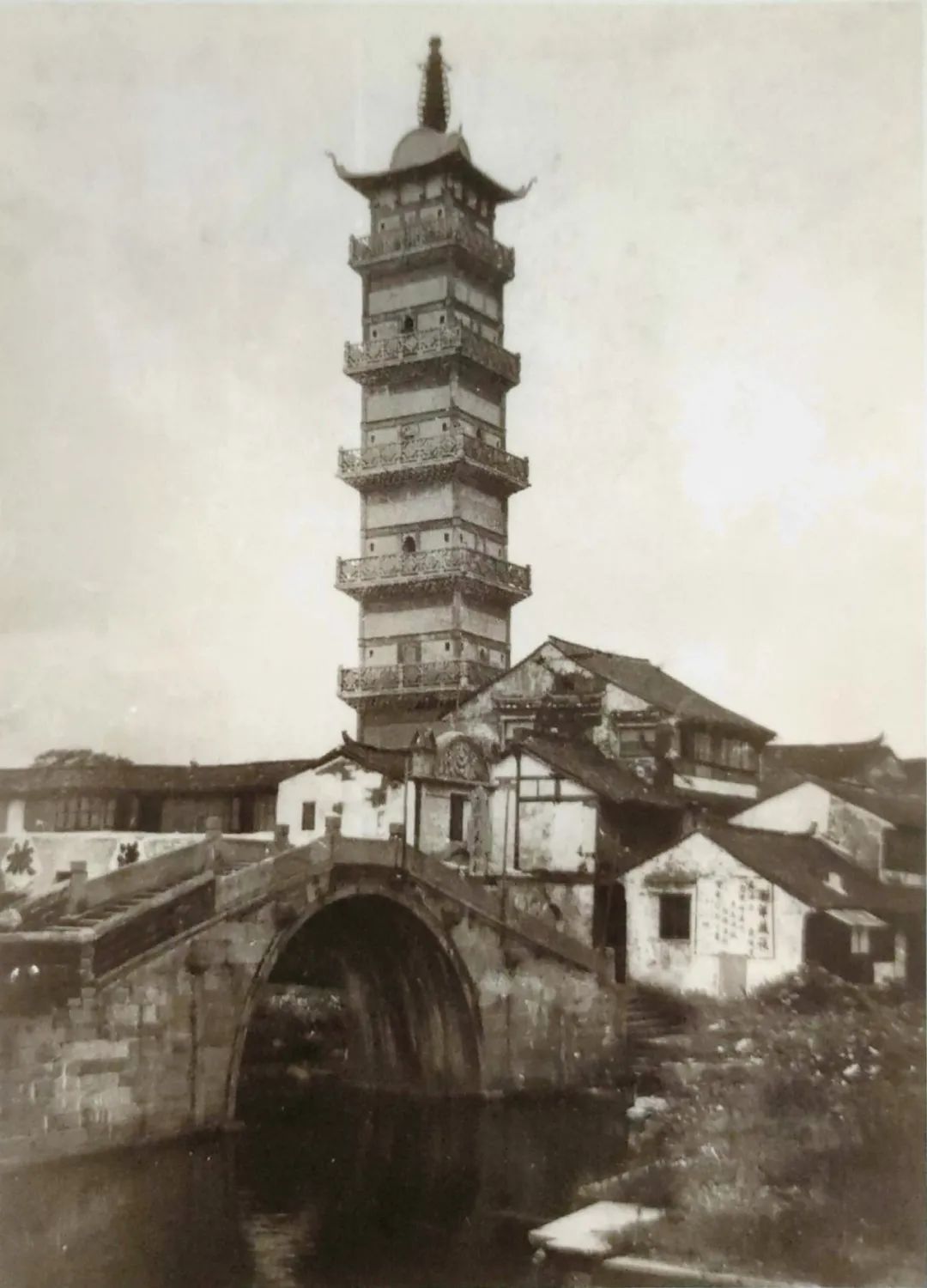
Fahua Tower around 1940
The Fahua Tower not only witnessed the historical changes of Jiading, but also carried the memories of generations of Jiading people. It is also a cultural relic protection unit in Shanghai, and a number of important cultural relics with great historical and artistic research value have been unearthed. The last time Fahua Tower was repaired was from 1994 to 1996. In the process of rectifying and repairing Fahua Tower, two underground palaces of the Ming Dynasty and Yuan Dynasty and the niches between the sixth and seventh floors were discovered successively. In the dark room, a batch of cultural relics from the Yuan and Ming dynasties were cleared out, including coins, Buddha statues, stone letters, silver boxes, bronzes, porcelain, jade, ancient books, etc. Most of them are now in the Shanghai Museum.
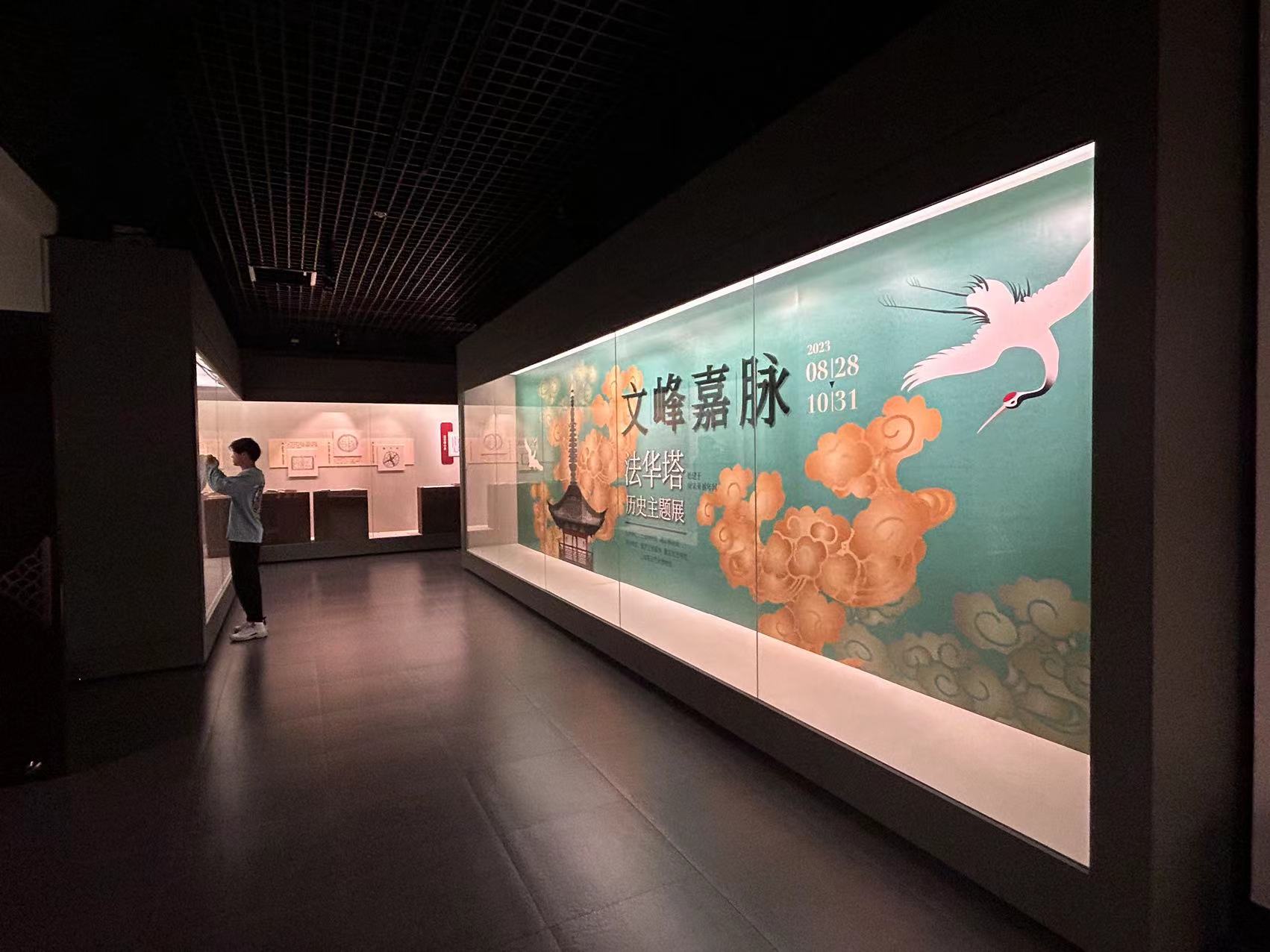
Exhibition site (Photographed by The Paper reporter)

Yuan Dynasty Celadon Relic Box Discovered in the Yuan Dynasty Underground Palace of Fahua Tower in 1996

Yuan Shoushan Stone Maitreya Buddha Statue Discovered in the underground palace of the Yuan Dynasty at the Fahua Tower in 1996

Yuan Agate sheep talus discovered in the underground palace of the Yuan Dynasty at the Fahua Tower in 1996
Taking the opportunity of Fahua Tower's revival, the Shanghai Museum and Jiading Museum jointly held the "Wenfeng Jiamai-The History of Fahua Tower Exhibition", which gathered for the first time 36 pieces (groups) of precious cultural relics unearthed from the Tiangong and Digong in the Fahua Tower. Jiading Museum on display. The exhibition was also officially opened to the public on August 28. For the citizens of Jiading, this is also a rare opportunity to directly face the cultural relics unearthed from Fahua Tower.
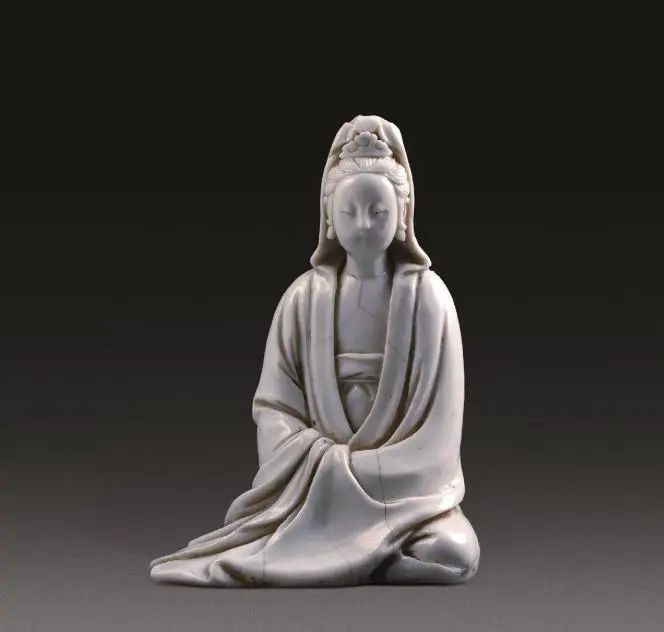
Ming Dynasty Dehua Kiln White Glazed Avalokitesvara Discovered in 1996 in Fahua Tower Tiangong
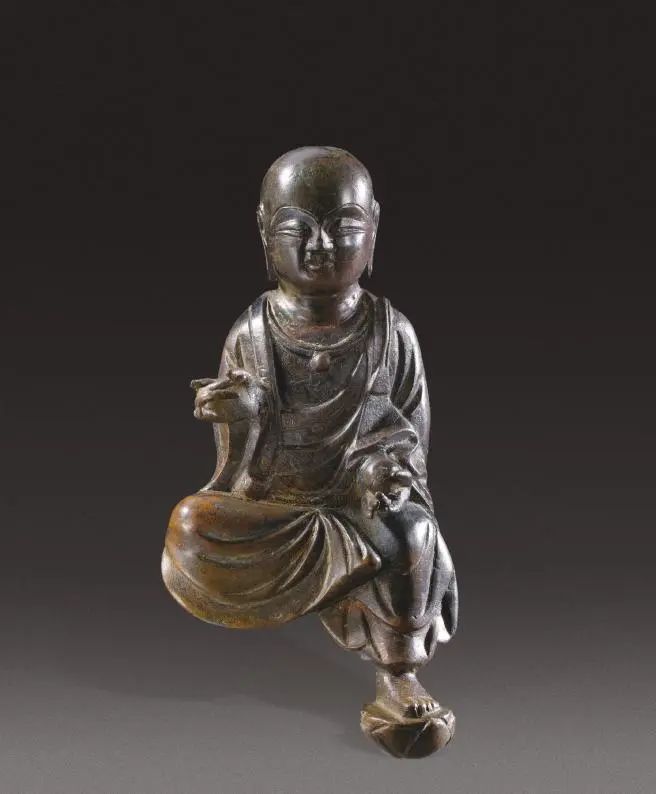
Ming Bronze Arhat Statue Discovered in Fahua Tower Tiangong in 1996
The exhibition is divided into "Looking Back on the Vicissitudes of Life: The Historical Changes of Fahua Tower", "Archaeological Relics: Precious Cultural Relics of Fahua Tower", "Xuanwu of Learning: Fahua Tower and Jiading Context", "Jinsha Sunset: Fahua Tower Described by Literati of Past Dynasties" Together with the five parts of "Moonlight at that Time: People's Stories of Fahua Tower", a total of more than 80 related exhibits (sets) were exhibited, covering jade, pottery, bronze, porcelain, ancient books, calligraphy and painting and other types.

Yuan Bronze Eight Trigrams Inscription Mirror Discovered in 1996 in Fahua Pagoda Ming Dynasty Underground Palace
The exhibition reviews the cleaning process of Fahua Tower's Tiangong and Digong. Firstly, the underground palace of the Ming Dynasty was cleared out, and the stamp on the side of the Beijing brick was stamped in the thirty-fourth year of Wanli in the Ming Dynasty (1606). The seven-star eight-diagram bronze mirror, coins and other cultural relics from the Jiajing, Longqing and Wanli periods were also cleared. After continuing to clean up, we found the underground palace of the Yuan Dynasty, and three exquisitely carved and colorful stone letters were placed vertically in sequence. Inside the stone box are bronze Buddha statues, stone Bodhisattva statues, iron towers, silver boxes, porcelain relic boxes, copper incense burners, copper ear-piercing vases, jade Maitreya Buddha, jade figures, jade carved animals, agates, crystals and other ornaments. Stone statues and dozens of kilograms of coins. Since then, a number of important cultural relics have been discovered again in the dark room of the alcove between the sixth and seventh floors of Fahua Tower. These cultural relics are placed in four fir boxes, including more than 40 pieces of gold and bronze Buddha statues, porcelain Guanyin statues, porcelain incense burners, wooden vases, Ming Dynasty coins, and ancient books. On the inner wall of the wooden box, "disciple Ren Liangyoushe" and other ink writings are clearly legible. At the same time, a stele recording the main cultural relics hidden in Tiangong was also found on the inner wall of Fahua Tower.
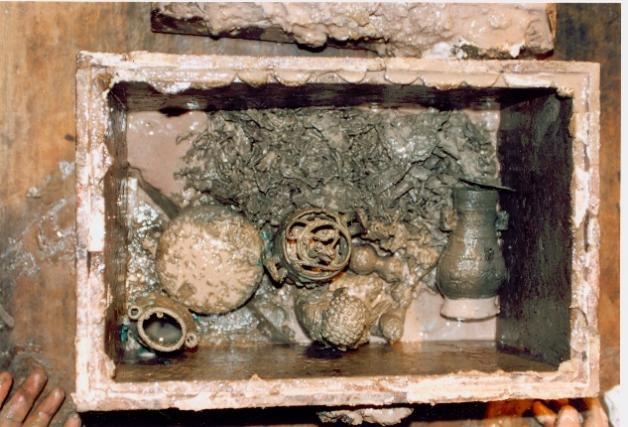
Fahua Tower underground palace cleaning site

Cleaning site of Fahuata Tiangong

Cleaning site of Fahuata Tiangong
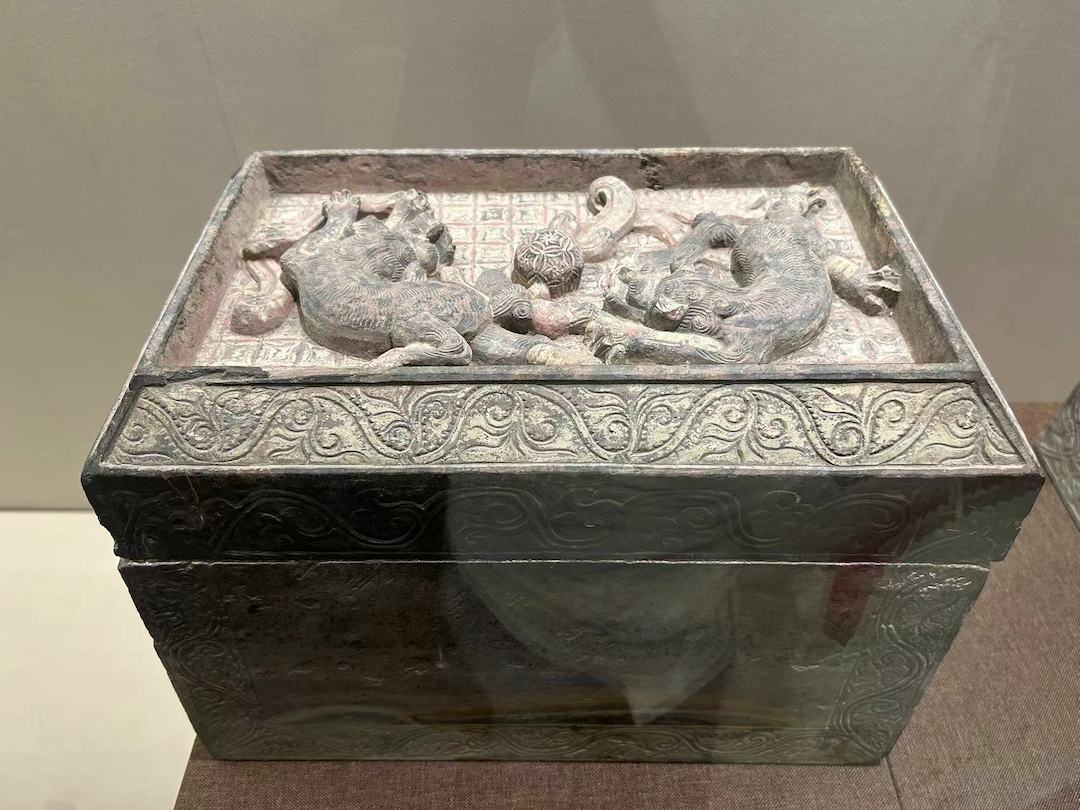
Stone letter unearthed from the underground palace of Fahua Tower at the exhibition site
The audience can now see the true content of these cultural relics in the exhibition hall of Jiading Museum. The white jade dancing girl of the Jin Dynasty, the face of the dancing girl and the Liao jade flying apsaras unearthed from the North Tower Tiangong in Chaoyang, Liaoning, the jade flying apsaras unearthed from the tombs of the Jin Dynasty around the Zhongxing ancient city in Suibin, Heilongjiang, and the brick carvings on the northwest wall of the Jingcungou golden tomb in Xiangfen, Shanxi The faces of the maids are similar, and they have the image characteristics of northern nomads. It can be used as a standard device for dating jade dancers from the Liao and Jin Dynasties.

Jin Dynasty white jade dancer

Yuan Dynasty Gilt Bronze Buddha Statue
This Yuan Dynasty gilt bronze Buddha statue on display is similar to a Qingtian stone Sakyamuni Buddha statue found in the Yuanying Pagoda Palace in Songjiang, and has a clear Tibetan Buddhist statue style.
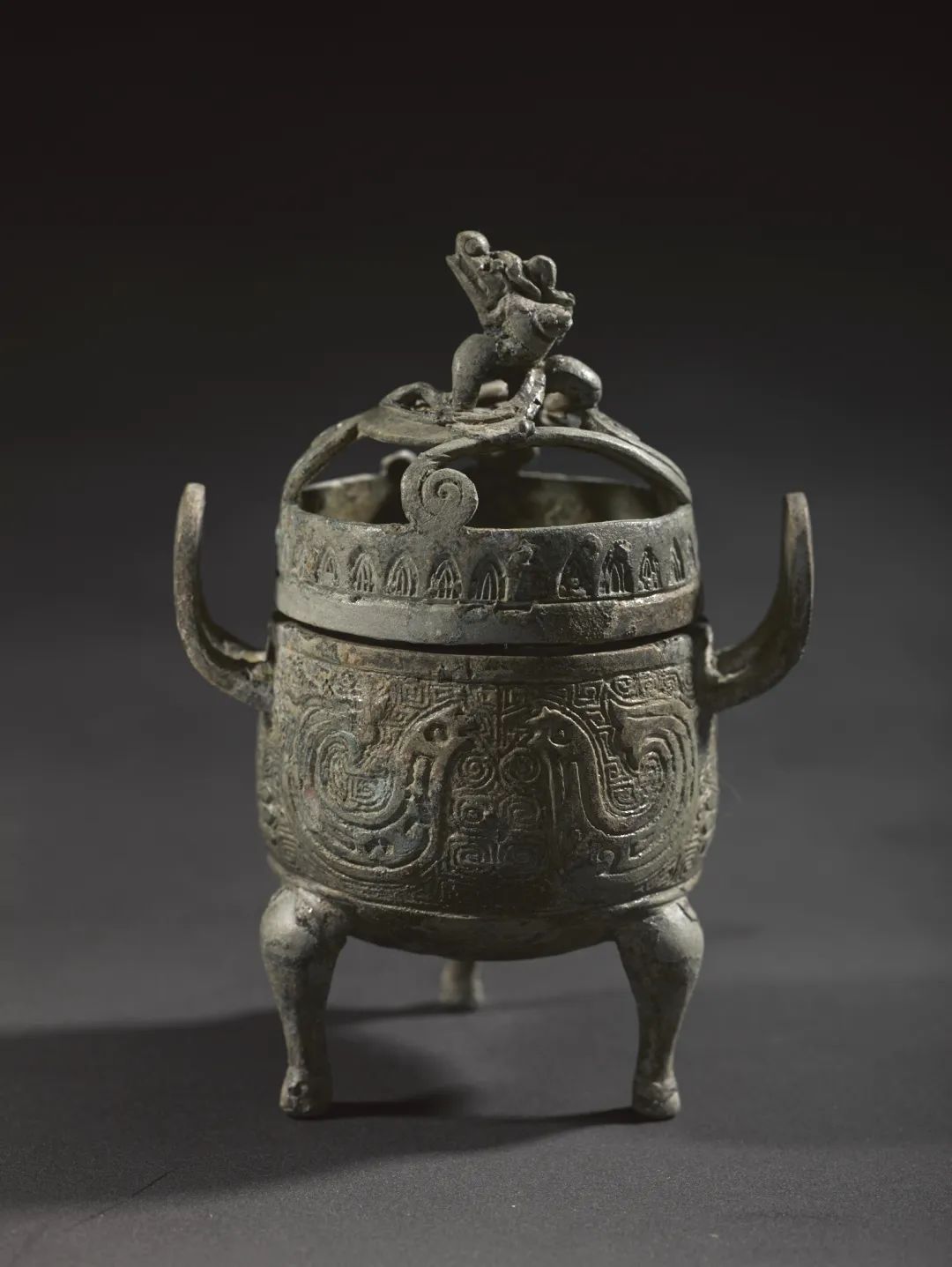
Copper smoker Yuan Dynasty (1271-1368) Discovered in 1996 in the Yuan Dynasty underground palace of Fahua Tower
The copper smoker of the Yuan Dynasty on display is an antique bronze ware of the Yuan Dynasty, and it is a smoker with a cover. There are two phoenix birds at the front and back of the abdomen, with their phoenix heads facing each other, stretching their necks and raising their heads, looking round their eyes, with their mouths wide open and their long tails curled up. The image is vivid and realistic.
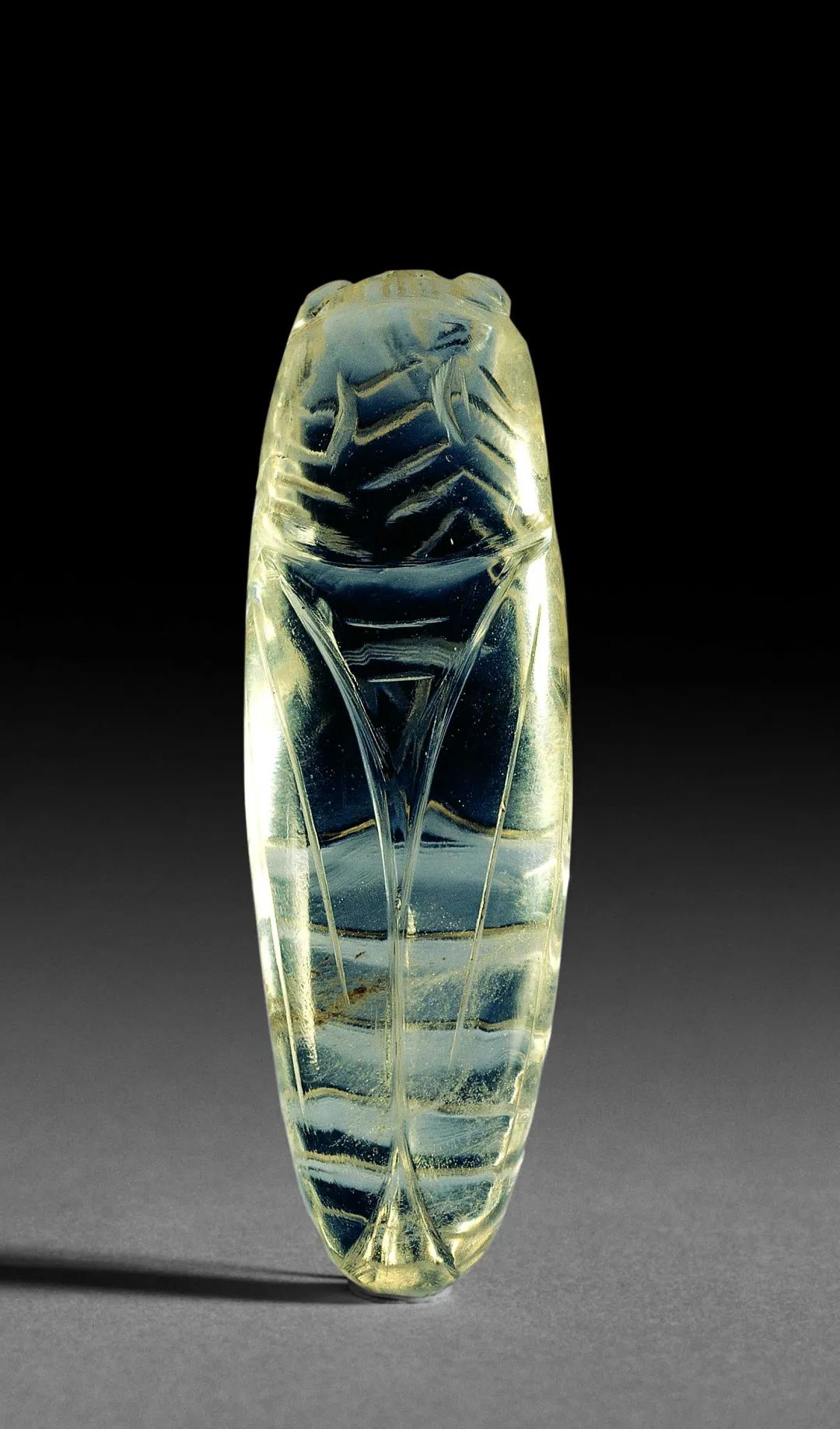
Crystal Cicada Yuan Dynasty (1271-1368) Discovered in 1996 in the underground palace of the Yuan Dynasty at the Fahua Tower
This crystal cicada is colorless and transparent. Cicada, because of its life cycle and habit of drinking dew, has been endowed with the meaning of resurrection, immortality and nobility since ancient times. Cicada-shaped ornaments were discovered in the Hongshan Culture and Liangzhu Culture five thousand years ago. The development peaked from the Shang Dynasty to the Han Dynasty. This cicada is slightly rounded and has a vigorous style. Although it is different from the Han style, it still does not lose the rough and simple atmosphere of the Yuan Dynasty.

exhibition site
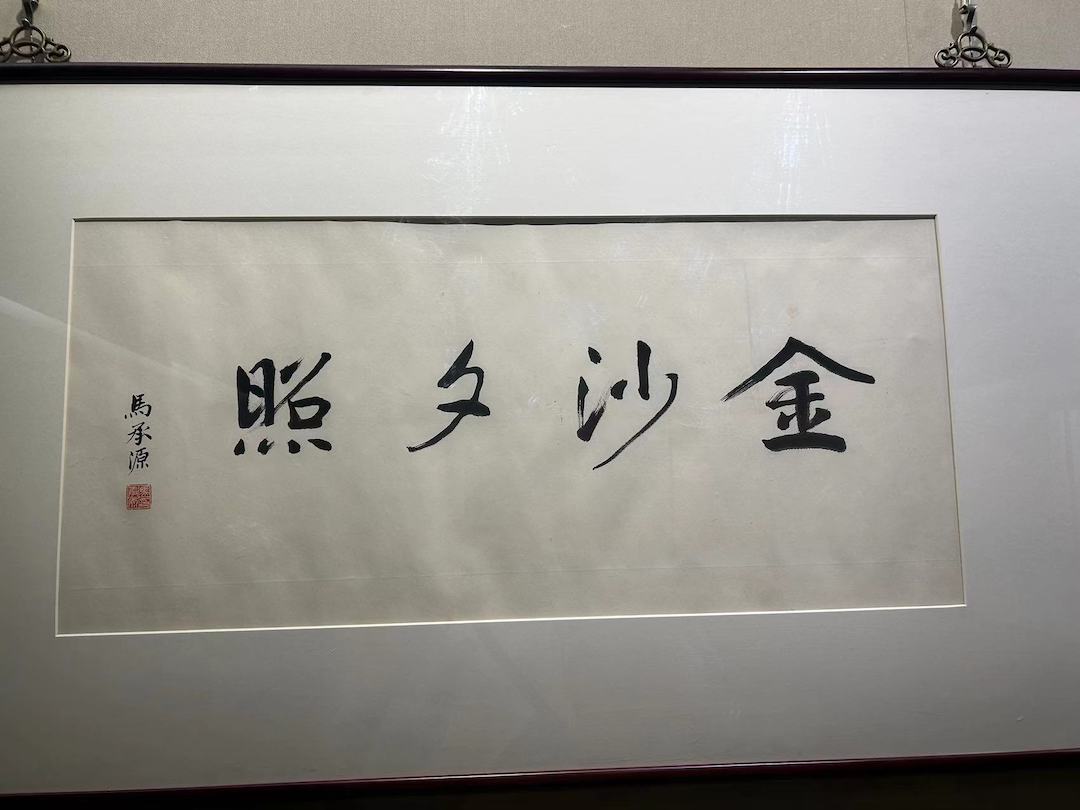
exhibition site
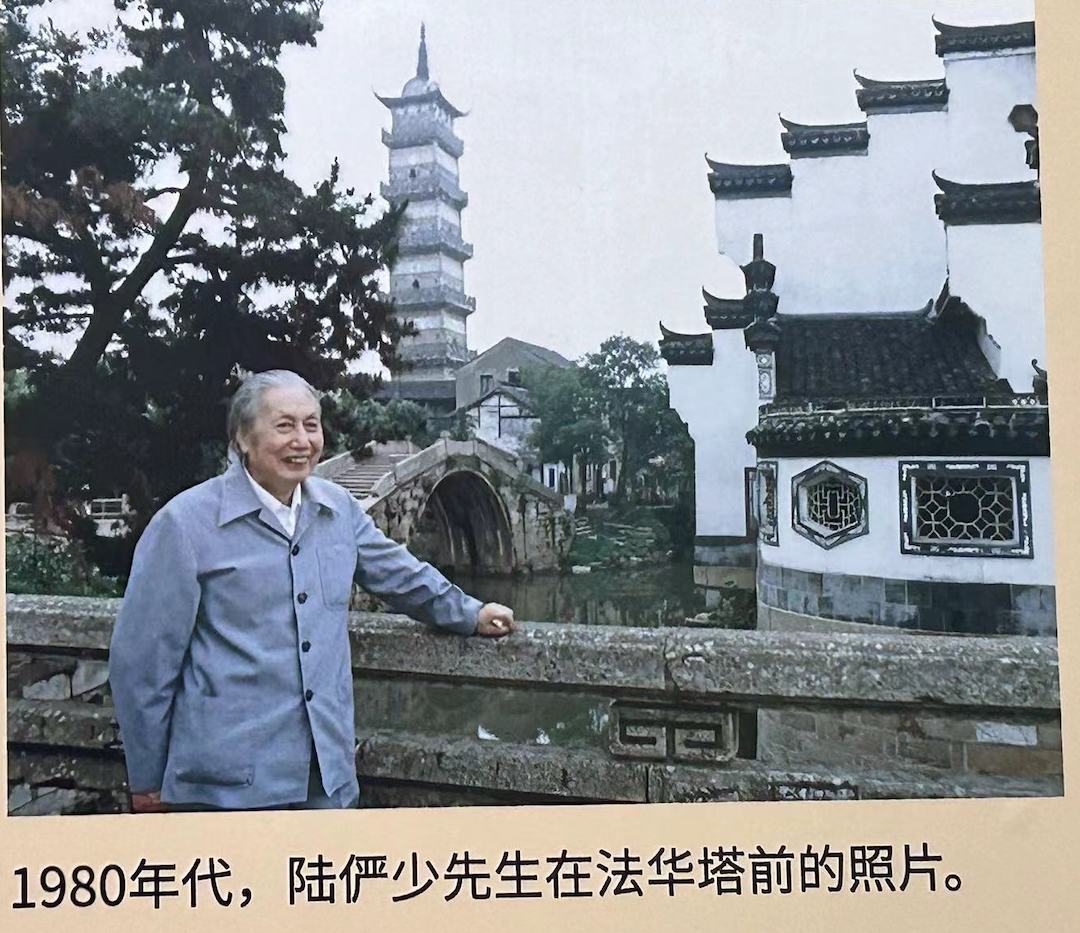
exhibition site
This exhibition uses rich historical materials and cultural relics to trace the historical context of the Fahua Tower and the stories of the residents under the tower.
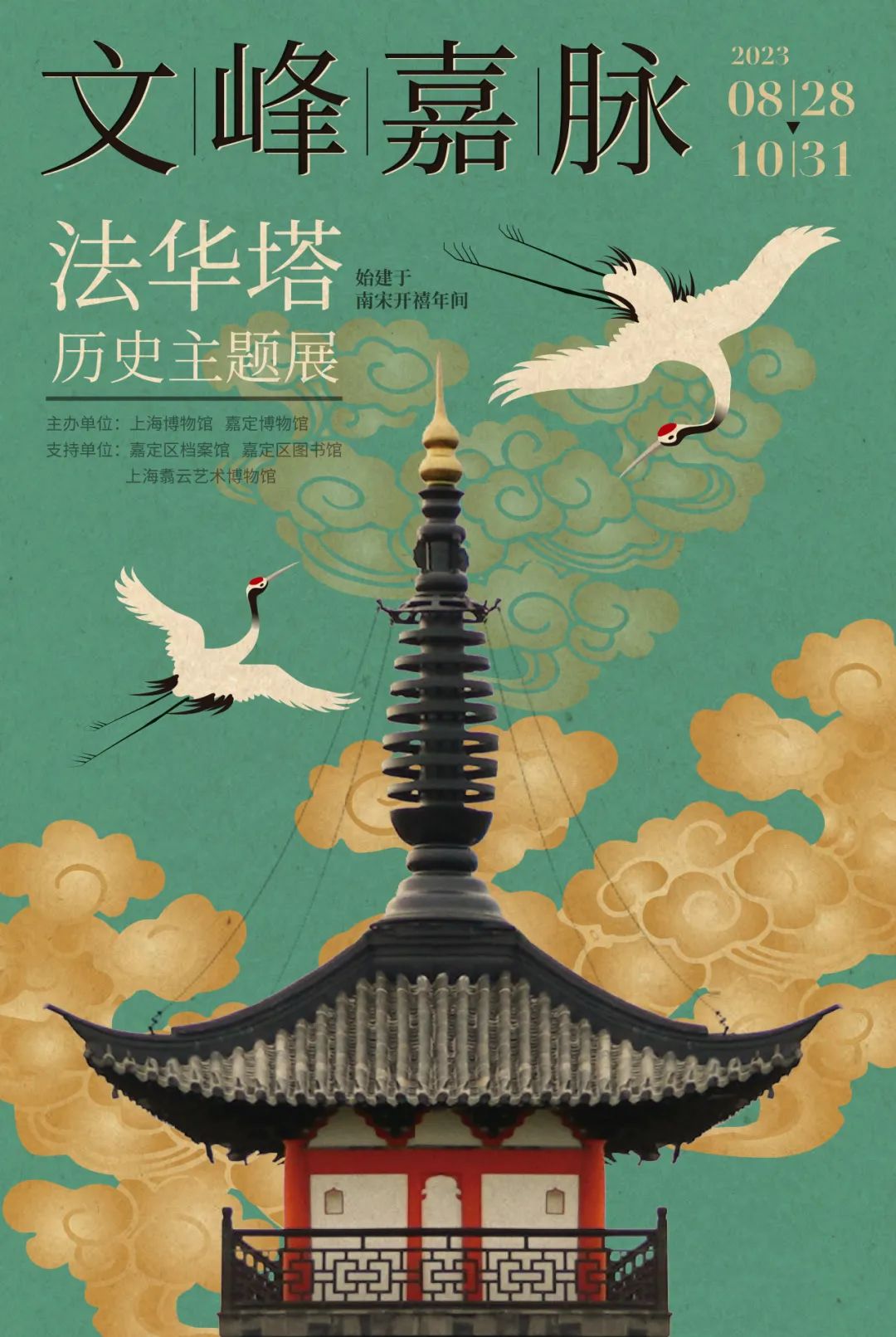
exhibition poster
Note: The exhibition will last until October 31. The pictures not marked in this article are all from Jiading Museum.


